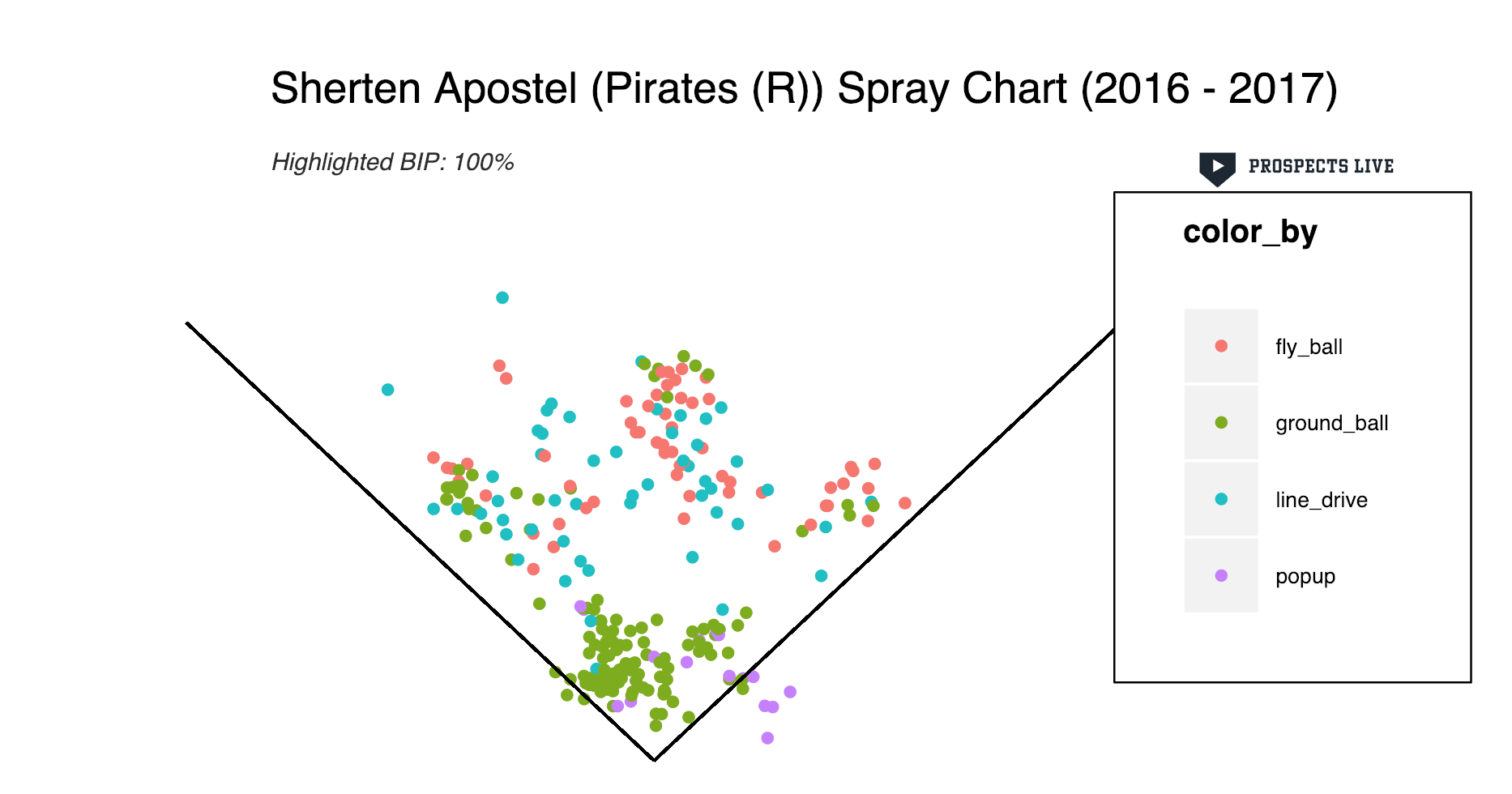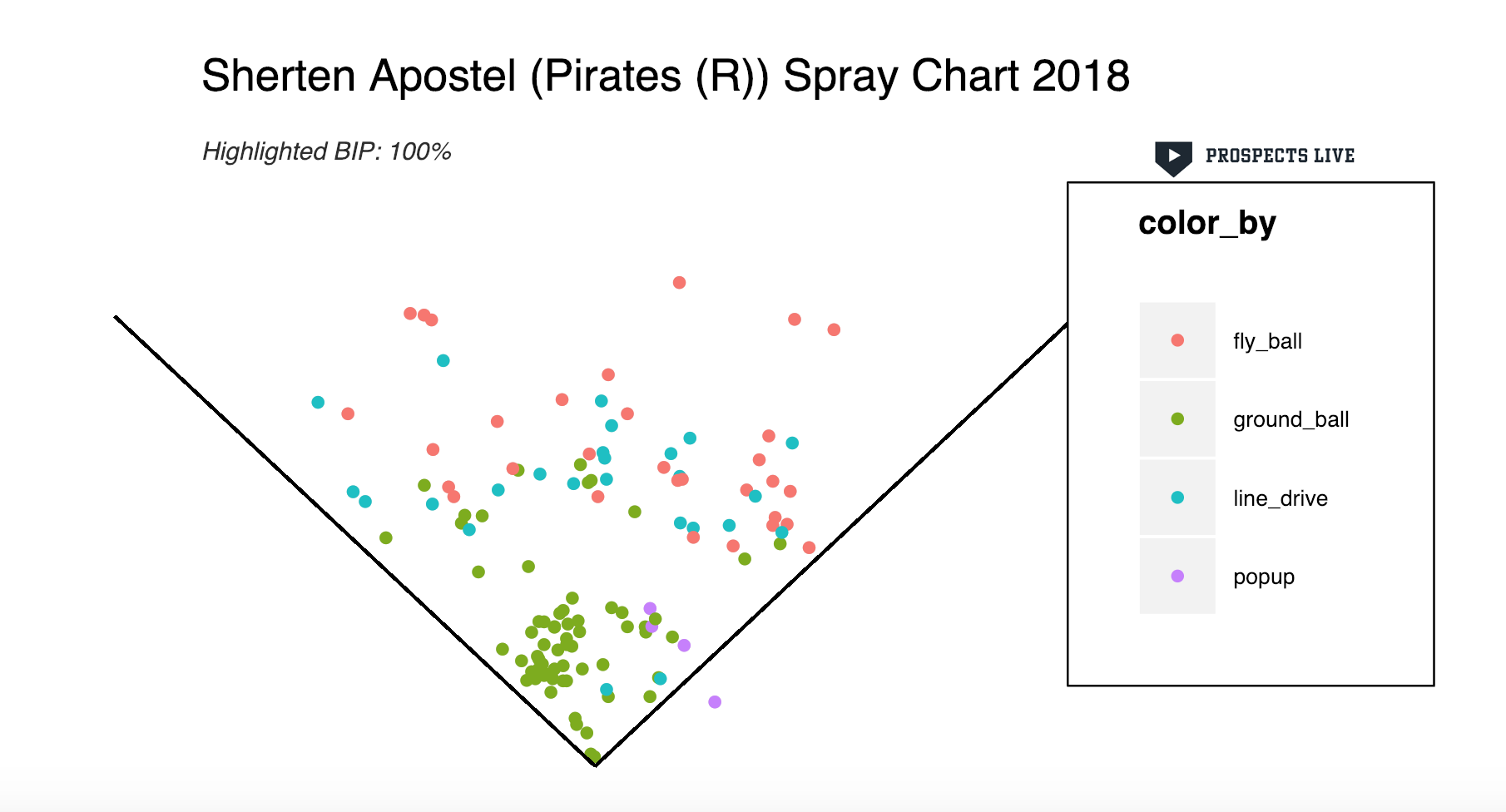You never know what’s going to trigger it. Sometimes, it’s an at-bat. Other times it’s a statistic. But you see something or read something that sparks a flame that grows stronger and before you know it, you’re officially obsessed with a prospect and flying him up your ranks.
This is what’s happened with me regarding Texas Rangers 3B Sherten Apostel over the course of the offseason. That “love at first sight” moment came after watching Jason Pennini’s video:
JP’s clip has more than 1,200 views and I’m sure I’m at least 750 of them. It’s easy to capture a batter or a pitcher looking good when you have a one-pitch sample. But man, that swing. The kinetic chain is in perfect display there as he transfers the energy from his legs up to his bat. If you want to see an example of what “easy power” looks like, this is it.
This clip set me off in trying to learn more about Apostel and little by little I uncovered more and more things I liked about him.
The Background
In 2015, Apostel signed with the Pittsburgh Pirates for $200,000 out of Curacao, the same island nation that’s produced Andruw Jones, Ozzie Albies, Andrelton Simmons and Jurickson Profar. It was a low profile signing as Apostel didn’t appear on any 2015 International Free Agent Rankings. In fact, if you search his name and set the parameters to the year 2015, Google returns only one page of results, none relevant to his signing.
He was reportedly considered as a pitcher thanks to his frame and his plus arm but the potential with the bat, in spite of his rough defense, was too good to turn down. As he slowly made his way through the rookie ball leagues, he improved and began showing a magnificent approach at the plate. In August of last year the Pirates named him the PTBNL in a trade that sent LHP Taylor Hearn to the Texas Rangers for Keone Kela.
The Numbers
In his debut season, a 48-game campaign in the DSL, a 17-year-old Apostel failed to impress. He pulled the ball a ton, mashed it into the ground and had just nine extra-base hits in 171 at-bats. Flip the calendar to 2017 and things started to click. Apostel, once again repeating the DSL, slashed .258/.422/.495 with a 56/49 BB/K. His 21.6 BB% that year led the DSL for all batters with a minimum of 200 plate appearances (206 players).
That same approach and similar slash line appeared this past season when Apostel began the year in the Appy League. He hit .259/.406/.460 in 41 games with an ISO above .200 again. His walk rate was superb, hovering at 18 percent. After the trade, the Rangers assigned him to short-season ball where he powered the Spokane Indians to the Northwest League championship before falling to Eugene. His numbers were stupid good, but it was just a 12-game stint so they’re not worth the digital ink.
The Changes
Box scores are nice, especially when they look as pretty as Apostel’s the last two seasons, but what else can we glean? Thanks to Minor Graphs, there are a couple of other trends we can pick up. First, it’s that the power is growing. This is Apostel’s calling card, and he’s learned to leverage his 6-foot-4, 215-pound frame in games, especially last year.
The average flyball distance itself is nothing to write home about just yet. For reference, Eloy Jimenez routinely hangs out in the 320 ft. range. But that doesn’t mean Apostel doesn’t possess great raw power. I’d go as far to say he has double-plus raw. It’s more of a matter of consistently getting to it in games and we can see that in a small sample he began doing that.
He’s also begun utilizing more of an all-fields approach.
Not often do we like to see graphs trending down but this one is an exception! In his first two years in the DSL he pulled more than 50 percent of his batted balls, but dropped that to just above 40 percent in 2018.
Here’s that visualization using his spray chart. Notice the volume of ground balls in 2016-17 to the left side of the infield and compare in 2018. There is still a tendency to pull them a bit, but not as much and his fly balls are distributed much more evenly.
Finally, his swinging strikes have been following a positive trajectory as well.
2016: 36.5 SwStr%
2017: 24.5 SwStr%
2018: 12 SwStr%
The Conclusion
Apostel is someone who has a very appealing set of fantasy skills and is slowly getting better. The big question centers around his hit tool. When JP posted that tweet that’s at the top of this story, I asked if he thought long levers would get in the way of maximizing his plate potential. He said in his look the levers weren’t problematic, but cautioned that Apostel is still growing, which is a scary thought. JP ranked Apostel seventh in his Rangers Top 30. In his blurb, he even teased us and said that a 60 hit/60 power bat may be lying dormant. Is that hit tool prognostication aggressive? Yup. But JP is big into mechanics and I trust his judgment. If we want to be conservative and say he tops out at an average hit tool, that’s still a fantastic outcome given the huge power. In other words, with his selectivity, I don’t see how he maxes out at a 40 hit tool, which is what I’ve seen elsewhere.
At prime and with said average hit tool he can be a 6-foot-5, 235-pound monster who’ll post excellent walk rates, keep the strikeout rate in the low 20 percent and flash 30-home run power with a slash line that might look something like .255/.370/.530. That’s a star at the plate, you guys. There is a chance he could outgrow third base, but his arm is such a weapon that the Rangers will want to keep him there as long as possible.
I’ve spent this piece hyping up Apostel (and for good reason, as I hope you’ve now read). But I’ll caution that he’s yet to see full-season ball. The Rangers are an aggressive organization so it wouldn’t surprise me to see them assign him to Hickory in the SAL to open 2019 with a chance to climb to High-A if he replicates his usual numbers.
As it stands there isn’t a major change Apostel needs to make to get better. It’s just a matter of seeing how he handles better quality competition and slowly increasing his FB% to continue tapping into his power.
I have him just inside my fantasy top 100 (coming later this month!) and in OBP leagues I would pursue aggressively because his floor is significantly higher in that format.
I started this post with a video, let’s end it with another. Here’s a clip of an opposite field home run he hit in the U-23 Baseball World Cup last year. He demolishes that 82 mph pitch on the outside, once again making that oppo pop look easier than it should. In 32 at-bats in that tournament, he was the star of the Netherlands squad, hitting .375/.444/.750 with almost twice as many total bases (24) as his next closest teammate.
Get in now while you can.





